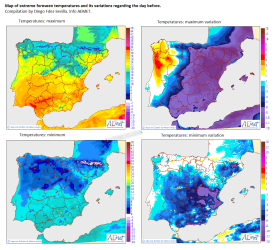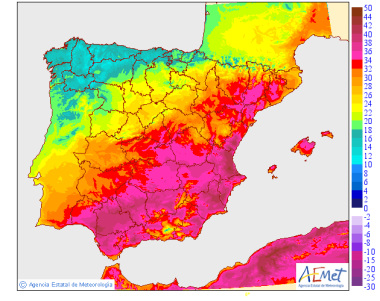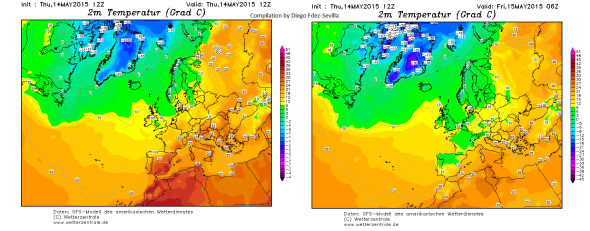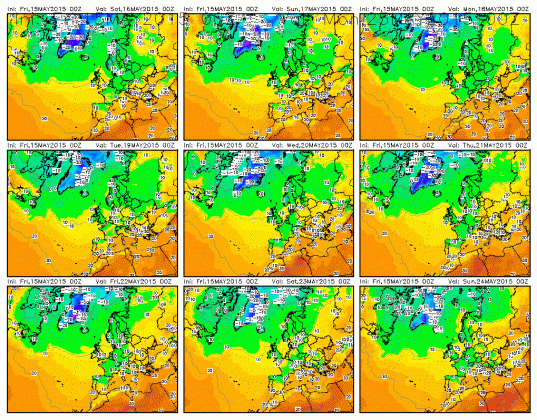A roller-coaster of temperatures in South Europe. Spain (by Diego Fdez-Sevilla PhD)
By Diego Fdez-Sevilla PhD.  CV english and español. Resume. Interdisciplinary Skills applied in the line of research presented.- Index for all analyses published. – Shares and Feedback at LinkedIn
CV english and español. Resume. Interdisciplinary Skills applied in the line of research presented.- Index for all analyses published. – Shares and Feedback at LinkedIn
(Registered at ResearchGate: DOI: 10.13140/RG.2.2.27634.20165)
________________________________________________
A new record maximum temperature for Spain was set yesterday 13th May, with many local records also broken, and the heat continues today (14th May) in the southeast (Temp on 14th May: All-Time May Heat Record for Europe Falls For the 2nd Time This Month.By: Jeff Masters. May 14, 2015).
The new record of 42.6C was recorded at Lanzarote Airport in the Canary Islands, beating the previous May record for Spain by a relatively large 2.5 degrees. It also beats the Lanzarote station’s own previous highest May temperature by a whopping 6 degrees.
The previous May record in Spain was 40.1C at Cordoba on the mainland, and Cordoba itself recorded a new May station record on Wednesday with 41.2C.
Further records could be broken today in parts of Andalucía, Mercia and Valenciana as air continues to feed in from North Africa. However, a cold front is pushing gradually southeastwards across Spain, bringing cooler air across much of the country by the end of the week.
What next?
Well, next we have the forecast for a sudden drop of Temp in just 24 hours and even moving to freezing (0ºC) on Wednesday 20th May.

Map of extreme foreseen temperatures and its variations on the 15th May regarding the day before 14th May.

Map of extreme foreseen temperatures and its variations on the 16th May regarding the day before 15th May 2015.
Starting from Wednesday May 20th polar-maritime air masses will flow towards Spain, with drops in temperature being forecasted reaching as low as 0ºC in some parts of the North of Spain (2m Temp Forecast GFS).
I believe that the Iberian peninsula can be a very relevant indicator for the potential evolution of global changes in atmospheric developments and climatic anomalies, due to its position in Latitude and conglomeration of contrasts in a relatively small space of climatic influences, from Oceanic and maritime in the West and East to continental from North Europe and Africa in the South. Cold blasts have found their way South in Winter and burning Heat has no opposition moving North now 14th May. And these anomalies are not Solar related by activity or angle of incidence.
Follow up from previous posts:
This type of situations brings back some previous discussions addressed in several posts, in which I have point out the relevance of facing changes in the severity for the transition between climatic phases due to atmospheric alterations.
From: New theory proposal to assess possible changes in Atmospheric Circulation (by Diego Fdez-Sevilla) October 21, 2014 DOI: 10.13140/RG.2.1.4859.3440
The theory that I have developed follows the work published previously by scientists Judah Cohen, Masato Mori, Colin Summerhayes, Coumou and Ted Shepherd, whom all together supported the theory of that early snowfall over Asia increases albedo leading to heat retention in the atmosphere provoking Arctic ice to melt. Decreased snow cover decreases albedo and enhance heat absorption. Ultimately, the enhanced capacity of the Arctic to absorb heat would lead to “amplify” atmospheric heat absorption already being fuelled with GHGs. Such increase in atmospheric temperature would reduce the thermal contrast required for a strong jet stream and consequently originating disturbance in atmospheric weather patterns associated.
What I propose with my hypothesis is that Arctic Amplification is a consequence and not the trigger. That it is a symptom and not the causation.
What I am trying to highlight in my theory are the possible mechanisms which would explain: changes in albedo which support Arctic Amplification, early snowfalls in central Asia, Arctic ice cover meltdown and oceanic increases in salinity and ultimately, the origin of atmospheric blocking patterns and the pause in T raise unified in single principle: Increasing conc. of CO2 and water vapour induce a decrease in the differential gradients of energy in atmospheric circulation.
I am looking at the implications of having the Arctic circulation not “Amplifying” but “Absorbing” constant increases in atm CO2 and Water vapour. In my approach, instead of looking at what happens in the Arctic as the origin of a chain reaction, I look at what happens in the Arctic just as a side effect (with its own implications) of a more wide process resultant from a reduction between the differential gradients of energy driving the atmospheric global circulation, being water vapour the carrier of the energy being dispersed all over the atmosphere.”
Based on my theory, Greenhouse gases store energy which leads to an increase in global temperature. This increase in T, altogether with synergistic effects of aerosols, allows more water vapor to be contained in the atmosphere, which consequently adds more energy into the atmosphere in form of latent heat and kinetic energy. Therefore, this increase in atmospheric energy being carried and distributed all over the hemisphere would infuse power into atmospheric patterns at the same time that it would also reduce the differential energetic gradient between cyclonic events and their surroundings in order to dissipate the energy carried within. Consequently, the energy of those cyclonic events (Low and High pressures) would persist for longer throughout time, altitude and location. Such scenario would decrease the strength of barriers build upon steep differential gradients like the Polar Jet Stream. Furthermore, it would increase the frequency in which masses of warm air from low latitudes would get introduced in polar regions as well as masses of polar air would move across the Jet Stream across latitudes moving further South. Following the 2nd Thermodynamics law on entropy, having decreased the differential in gradient of energy between cyclonic events and its surroundings would increase the life span of those events. That would induce an increase in the accumulation of energy in form of latent heat, water vapour and wind strength. Such build-up in power, without dissipating the energy contained within, would give cyclonic events enough strength to interfere with atmospheric barriers like the Polar Jet Stream breaking it, and also, would allow them to adopt locations that originate blocking pattern.”
From: Revisiting the theory of “Facing a decrease in the differential gradients of energy in atmospheric circulation” by Diego Fdez-Sevilla. Posted on February 10, 2015. DOI: 10.13140/RG.2.1.1975.7602
“The weakening of the Jet Stream would allow more frequent intrusions of masses of air from both sides, inducing sudden and extreme changes in weather patterns for Northern and Southern latitudes. Once the barrier weakens, “warm and wet” currents of air would reach further North being dragged by High pressures moving at higher latitudes without the opposition of the Jet Stream.”
From: Why there is no need for the Polar Vortex to break in order to have a wobbling Jet Stream and polar weather? (by Diego Fdez-Sevilla) November 14, 2014 DOI: 10.13140/RG.2.1.2500.0488
“Even considering that such exchange it has been always there throughout past Winters, if my theory is right, this pattern of unsteady Jet Stream and masses of air crossing through would start earlier in Autumn (seasonal transition to Winter) and resume closer to summer (until all warm masses of air cover high latitudes homogeneously).
The transition from Summer to Winter and from Winter to Summer will be a transition between “more frequent exchange of masses of air” to “less frequent”. Instead of having a constant gradual change in atmospheric conditions, we will have pockets of air moving across the Jet stream defining the weather wherever they move.”
From: Drops of Weather. (by Diego Fdez-Sevilla PhD) March 7, 2015
“The implications raising from such type of atmospheric behaviour are yet to be fully understood. To begin with, the possibility of having sudden intrusions of masses of air inducing extreme changes in meteorological variables might affect the life cycle of the biota since the most of it, plants and animals, follows changes on Temp and Humidity suffering behavioural, hormonal and physiological alterations. Also it must be considered the rapid respond to those variables from species with a quick metabolism. Many of which, insects and fungi, might suffer blooming rates of growth coinciding with a vulnerable stage in the development of other species like crops and wild plants. This scenario opens questions which I believe are worthy to be included in a debate about “the possibility of its increasing frequency in the near future”, also discussed in previous posts (UPGRADED 11 March2015) Revisiting the theory of “Facing a decrease in the differential gradients of energy in atmospheric circulation” by Diego Fdez-Sevilla.)“
From: Met Office. The Recent Storms and Floods in the UK (Feb 2014) (by Diego Fdez-Sevilla) February 17, 2014
Throughout my career I have studied and discussed the influence of atmospheric water vapour in the aerodynamic behaviour of one particle being part of the aerosol, pollen grains. In my research I already pointed out the need for further research about the implications of the biological atmospheric particle load by being involved in climate events through the microphysics of cloud formation due to the nuclei drop activity of such particles. Aerodynamics_of_pollen_grains_involved_in_sampling_efficiency. Thesis_by_Diego_Fernandez-Sevilla (2007)
Additionally, I also performed research about the impact that environmental heat increase and retention has in the atmospheric biological load due to the urban heat island effect. The results point out that the biological cycles of the biota are altered increasing the duration of their “pollen release” period (due to prolonged warm climatic conditions). The scenario created by the urban heat island effect has been already applied to extrapolate global climatic alterations in the biota suggesting an increase in plant performance (metabolism) inducing more bioaerosol released into the atmosphere.
Putting together my own experience in researching bioaerosols, my understanding of environmental processes and the findings by others I find enough dots connected to be very alert about the synergistic effects that the biota play and suffers as part of the whole system. For more about this topic you can check the links below and the posts from the categories at the top of this page (e.g. posts addressing the synergies between atmospheric events and Biological productivity.)
Repercussion for Agriculture.
News report in Spanish. 15 May 2015.
Agriculturaganaderiapesca.com “La ola de calor arrasa los campos de media España llevándose gran parte de su cosecha.”
Google translator. The heat wave coming over Spain is decimating much of its harvest.
Repercussion for Water and Energy Infrastructures and Resources.
News report from India. State reels under heat wave, Jaipur breaks 12-yr record at 45.9 C in May
JAIPUR: Heat wave conditions in the state aggravated on Monday with most places recording maximum temperatures above the normal notch. This also triggered water crisis and abrupt power outages in many parts of the state.
—- xxx —-
(This post is part of a more complex piece of independent research. I don´t have founding, political agenda or publishing revenues from visits. Any scientist working in disciplines related with the topics that I treat in my blog knows how to judge the contribution that my work could potentially add to the state of knowledge. Since I am in transition looking for a position in research, if you are one of those scientists, by just acknowledging any value you might see from my contribution, would not only make justice to my effort as independent researcher, but ultimately, it will help me to enhance my chances to find a position with resources to further develop my work.
I believe that the hypothesis that I have presented in previous posts in this blog (here, here and here) could help to understand present and possible future scenarios in atmospheric circulation. However, this is an assessment based on observation which needs to be validated throughout open discussion and data gathering. So please feel free to incorporate your thoughts and comments in a constructive manner.
If you feel like sharing this post I would appreciate to have a reference about the place or platform, by private or public message, in order for me to have the opportunity to join the debate and be aware of the repercussion which might generate d.fdezsevilla(at)gmail.com)
For anybody interested in the posts related with this discussion here I leave you those more relevant in chronological order (there are comments bellow some of them. Please check them out):
- New theory proposal to assess possible changes in Atmospheric Circulation (by Diego Fdez-Sevilla) Posted on October 21, 2014. http://wp.me/p403AM-k3
- Why there is no need for the Polar Vortex to break in order to have a wobbling Jet Stream and polar weather? (by Diego Fdez-Sevilla) Posted on November 14, 2014. http://wp.me/p403AM-mt
- Gathering data to make visible the invisible (by Diego Fdez-Sevilla) Posted on December 22, 2014. http://wp.me/p403AM-pN
- State of the Polar Vortex. Broken? From 29 Nov 2014 to 5th Jan 2015 (by Diego Fdez-Sevilla). Posted on November 29, 2014. http://wp.me/p403AM-o7
- Probability in the atmospheric circulation dictating the Weather (by Diego Fdez-Sevilla) Posted on January 15, 2015. http://wp.me/p403AM-rm
- Meteorological Outlook Feb 2015 (by Diego Fdez-Sevilla) Posted on February 7, 2015. http://wp.me/p403AM-sU
- Revisiting the theory of “Facing a decrease in the differential gradients of energy in atmospheric circulation” by Diego Fdez-Sevilla. Posted on February 10, 2015. http://wp.me/p403AM-to
- Matching Features Between Land Surface and Atmospheric Circulation (by Diego Fdez-Sevilla) April 23, 2015
- Drops of Weather. (by Diego Fdez-Sevilla) March 7, 2015
- Steering climate´s course (by Diego Fdez-Sevilla) March 27, 2015
- Climate. Looking at the forest for the trees (by Diego Fdez-Sevilla) April 9, 2015
- Matching Features Between Land Surface and Atmospheric Circulation (by Diego Fdez-Sevilla) April 23, 2015
- Domesticating Nature. (by Diego Fdez-Sevilla) May 7, 2015







 Would you like for this line of research to keep going, please consider to nominate it for an award for funds at
BBVA Fundation. FRONTIERS OF KNOWLEDGE AWARDS
https://www.frontiersofknowledgeawards-fbbva.es/conditions/
Would you like for this line of research to keep going, please consider to nominate it for an award for funds at
BBVA Fundation. FRONTIERS OF KNOWLEDGE AWARDS
https://www.frontiersofknowledgeawards-fbbva.es/conditions/ orcid.org/0000-0001-8685-0206
orcid.org/0000-0001-8685-0206

Pingback: Another roller-coaster of temperatures in South Europe. Spain (by Diego Fdez-Sevilla) May 13, 2015 | diego fdez-sevilla
Pingback: Our Environment. One Vision and Many Thoughts. (by Diego Fdez-Sevilla) | diego fdez-sevilla
Pingback: Atmospheric Circulation and the Mixing Zone. (by Diego Fdez-Sevilla) | diego fdez-sevilla
Pingback: When Temperature Becomes Something Else (by Diego Fdez-Sevilla) | diego fdez-sevilla
Pingback: The Butterfly Effect on Arctic Circulation. (By Diego Fdez-Sevilla) | diego fdez-sevilla
Pingback: Settled Science (by Diego Fdez-Sevilla) | diego fdez-sevilla
Pingback: Who has the right and the responsibility to discuss Climate as a topic of debate? (by Diego Fdez-Sevilla) | diego fdez-sevilla
Pingback: (UPGRADED 24th March2015) Revisiting the theory of “Facing a decrease in the differential gradients of energy in atmospheric circulation” by Diego Fdez-Sevilla. | diego fdez-sevilla
Pingback: Snap shot of a day 22 June 2016 (by Diego Fdez-Sevilla) | diego fdez-sevilla
Pingback: Indian Basin June 2016 (by Diego Fdez-Sevilla) | diego fdez-sevilla
Pingback: Research From The Bench (by Diego Fdez-Sevilla, PhD.) | diego fdez-sevilla, PhD.
Pingback: Dream Your Way Out (by Diego Fdez-Sevilla, PhD.) | diego fdez-sevilla, PhD.
Pingback: Foreseeable, at the moment. (by Diego Fdez-Sevilla, PhD.) | diego fdez-sevilla, PhD.
Pingback: Climbing The Hill Of Development (by Diego Fdez-Sevilla, PhD.) | diego fdez-sevilla, PhD.
Pingback: Climbing the Hill of Acknowledgement. Peer reviewed articles supporting previous assessments and research published in this blog. (by Diego Fdez-Sevilla, PhD. | diego fdez-sevilla, PhD.
Pingback: Climbing the Hill of Acknowledgement. Peer reviewed articles supporting previous assessments and research published in this blog. (by Diego Fdez-Sevilla, PhD.) | diego fdez-sevilla, PhD.
Pingback: Ups and Downs on Climatic Assessments. A Matter of Multiple Perspectives from the Same Point of View (by Diego Fdez-Sevilla, PhD.) | diego fdez-sevilla, PhD.
Pingback: Aug 2016 Follow-up on previous assessments. Atmospheric Dynamics, Temperature Displacements, Atmospheric Mixing (by Diego Fdez-Sevilla, PhD.) | diego fdez-sevilla, PhD.
Pingback: The True Meaning of Things (by Diego Fdez-Sevilla , PhD.) | diego fdez-sevilla, PhD.
Pingback: Summer is what summer brings (by Diego Fdez-Sevilla, PhD) | diego fdez-sevilla, PhD.
Pingback: In Climate, Too Many Strange Things Are Happening (by Diego Fdez-Sevilla, PhD) | diego fdez-sevilla, PhD.
Pingback: Between Global Cooling and Global Warming There Is “Global Mixing” (by Diego Fdez-Sevilla, Ph.D.) | diego fdez-sevilla, PhD.
Pingback: Solar Forcing in Our Climatic and Atmospheric Dynamics. Location, Location, Location (by Diego Fdez-Sevilla, Ph.D.) | diego fdez-sevilla, PhD.
Pingback: Forecasting Past Events In Atmospheric Dynamics (by Diego Fdez-Sevilla, Ph.D.) | Diego Fdez-Sevilla, PhD.
Pingback: A conversation between Joaquin and Matthew (by Diego Fdez-Sevilla, PhD.) | Diego Fdez-Sevilla, PhD.
Pingback: Global Mixing in Atmospheric Dynamics (by Diego Fdez-Sevilla Ph.D.) | Diego Fdez-Sevilla, PhD.
Pingback: Energy in our environmental systems. Follow-up on previous assessments. (by Diego Fdez-Sevilla, Ph.D.) | Diego Fdez-Sevilla, PhD.
Pingback: Another Heat Wave Another Polar Vortex II … Broken (by Diego Fdez-Sevilla, Ph.D.) | Diego Fdez-Sevilla, PhD.
Pingback: From Juno and Jonas to Janet (By Diego Fdez-Sevilla, Ph.D.) | Diego Fdez-Sevilla, PhD.
Pingback: Forecast Unusual (by Diego Fdez-Sevilla PhD) | Diego Fdez-Sevilla, PhD.
Pingback: Atmospheric Thermal Conductance (by Diego Fdez-Sevilla, PhD) | Diego Fdez-Sevilla, PhD.
Pingback: Just Thinking on Climate (by Diego Fdez-Sevilla, PhD) | Diego Fdez-Sevilla, PhD.
Pingback: “The Answer to the Ultimate Question of Life, the Universe, and Everything” is … 42 (by Diego Fdez-Sevilla, PhD) | Diego Fdez-Sevilla, PhD.
Pingback: RECAP on previous assessments (by Diego Fdez-Sevilla, PhD) | Diego Fdez-Sevilla, PhD.
Pingback: Worst than a change is a pattern of no change ( by Diego Fdez-Sevilla, PhD) | Diego Fdez-Sevilla, PhD.
Pingback: Orbital Melting vs Kinetic Melting (by Diego Fdez-Sevilla, PhD) | Diego Fdez-Sevilla, PhD.
Pingback: Temp Displacements. Solid Water In A Dessert Which Is Not At The Poles. (By Diego Fdez-Sevilla, PhD) | Diego Fdez-Sevilla, PhD.
Pingback: Following The Herd on Assessing Climatic Dynamics (by Diego Fdez-Sevilla PhD) | Diego Fdez-Sevilla, PhD.
Pingback: Breaking Stereotypes Assessing Climatic Dynamics (by Diego Fdez-Sevilla PhD) | Diego Fdez-Sevilla, PhD.
Pingback: Statistical Significance and The Scary Side of Being Mild (by Diego Fdez-Sevilla PhD) | Diego Fdez-Sevilla, PhD.
ResearchGate: DOI: 10.13140/RG.2.2.27634.20165
https://www.researchgate.net/publication/319007952_May_2015_A_roller-coaster_of_temperatures_in_South_Europe_Spain_by_Diego_Fdez-Sevilla_PhD
LikeLike
Pingback: A pattern of change in the atmosphere beyond considering global warming or cooling. That is, global mixing. (by Diego Fdez-Sevilla PhD) | Diego Fdez-Sevilla, PhD.
Pingback: 16 May 2019 Follow-Up on Atmospheric Dynamics over Europe and Climatic Implications (By Diego Fdez-Sevilla PhD) | Diego Fdez-Sevilla, PhD.
Pingback: Rayleigh–Taylor instabilities in Atmospheric Circulation. Follow-Up on Atmospheric Dynamics and Climatic Implications (By Diego Fdez-Sevilla PhD) | Diego Fdez-Sevilla, PhD.
Pingback: Climate. A Matter of Perspective (Diego Fdez-Sevilla PhD) | Diego Fdez-Sevilla, PhD.
Pingback: 6 Years Anniversary on a new Theory on Climate and Atmospheric Developments: “Facing a decrease in the Gradients of Energy in Atmospheric Circulation.” By Diego Fdez-Sevilla PhD. | Diego Fdez-Sevilla, PhD.
Pingback: Seasonal Alterations and Climate Change. Autumn 2020 D. Fdez-Sevilla PhD | Diego Fdez-Sevilla, PhD.
Pingback: Our Climate 2.0 by Diego Fdez-Sevilla PhD | Diego Fdez-Sevilla, PhD.